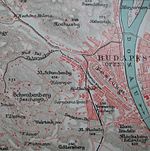Thomas Mann Gymnasium (Budapest)
1908 establishments in HungaryEducational institutions established in 1908German international schools in EuropeGymnasiums in HungaryPrivate schools in Hungary ... and 1 more
Schools in Budapest

The German School of Budapest - Thomas Mann Gymnasium (commonly referred to as DSB) (German: Deutsche Schule Budapest - Thomas Mann Gymnasium) is a private international school in Budapest, Hungary. It was founded in 1908 to serve German families in Hungary. It now has a diverse student body with primarily children of the expatriate business and diplomatic communities. Considered to be one of the best schools of its kind, it was awarded a Certificate of Excellence by the Central Agency for German Schools Abroad in 2012 and again in 2020.
Excerpt from the Wikipedia article Thomas Mann Gymnasium (Budapest) (License: CC BY-SA 3.0, Authors, Images).Thomas Mann Gymnasium (Budapest)
Cinege út, Budapest Kútvölgy
Geographical coordinates (GPS) Address External links Nearby Places Show on map
Geographical coordinates (GPS)
| Latitude | Longitude |
|---|---|
| N 47.5096 ° | E 18.9837 ° |
Address
Budapesti Német Általános Iskola és Gimnázium
Cinege út 8/c
1121 Budapest, Kútvölgy
Hungary
Open on Google Maps







